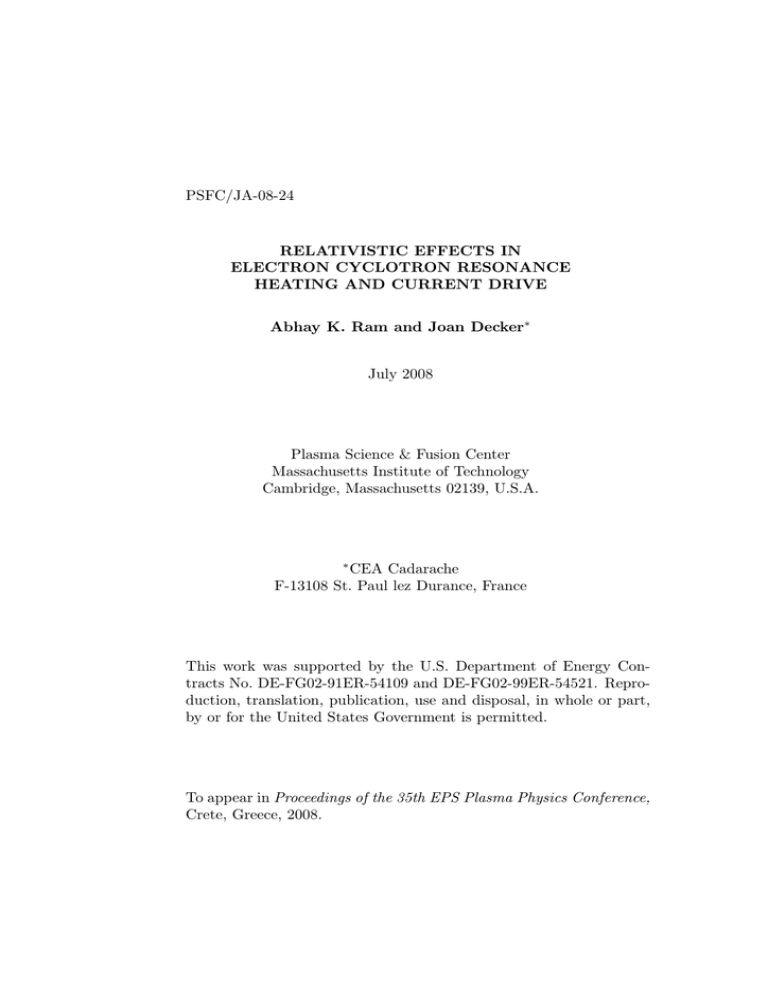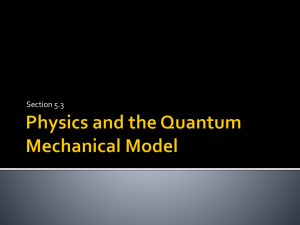PSFC/JA-08-24 RELATIVISTIC EFFECTS IN ELECTRON CYCLOTRON RESONANCE HEATING AND CURRENT DRIVE
advertisement

PSFC/JA-08-24 RELATIVISTIC EFFECTS IN ELECTRON CYCLOTRON RESONANCE HEATING AND CURRENT DRIVE Abhay K. Ram and Joan Decker∗ July 2008 Plasma Science & Fusion Center Massachusetts Institute of Technology Cambridge, Massachusetts 02139, U.S.A. ∗ CEA Cadarache F-13108 St. Paul lez Durance, France This work was supported by the U.S. Department of Energy Contracts No. DE-FG02-91ER-54109 and DE-FG02-99ER-54521. Reproduction, translation, publication, use and disposal, in whole or part, by or for the United States Government is permitted. To appear in Proceedings of the 35th EPS Plasma Physics Conference, Crete, Greece, 2008. Relativistic Effects in Electron Cyclotron Resonance Heating and Current Drive Abhay K. Ram1 , Joan Decker2 1 Plasma Science and Fusion Center, Massachusetts Institute of Technology Cambridge, MA 02139-4307. USA. 2 Association Euratom-CEA/DSM/DRFC Cadarache, 13108 Saint Paul lez Durance, France. In the electron cyclotron range of frequencies (ECRF), the extraordinary X wave or the ordinary O wave has been successfully used in many conventional tokamaks for generating plasma current and for modifying the current profile. ECRF waves are expected to play a similarly important role in ITER for current profile control. Also, in the EC frequency range, electron Bernstein waves (EBW) have been used for heating and for current generation in stellarators, conventional tokamaks, and a levitated dipole. EBWs are also highly suitable candidates for current profile control in overdense plasmas encountered in spherical tokamaks (ST). It is wellknown that relativistic effects need to be included in a proper description of the propagation and damping of EC waves. We have developed a code R2D2 which numerically solves the fully relativistic dispersion relation for all EC waves [1]. The results from R2D2 provide an insight into the properties of EC waves and the effect of relativity on the damping of these waves. In this paper we discuss the similarities between the interaction of O waves with electrons in ITER-type plasmas and the interaction of EBWs with electrons in STs. Relativistic Effects in Wave Damping We have developed a fully relativistic code R2D2 which solves for wave propagation and damping of all waves in the electron cyclotron range of frequencies (ECRF) [1]. This code has been used in a number of studies on electron cyclotron waves and electron Bernstein waves (EBW) [1, 2]. Results from R2D2 on the damping of the ordinary O waves in plasmas which are ITER-like and the damping of EBWs in plasmas which represent present day STs are discussed below. In Fig. 1(a) we plot the imaginary part of n⊥ , calculated from R2D2, as a function of ω /ωce for the O wave in ITER-type of plasma conditions. Here n⊥ is the wave index perpendicular to the magnetic field, (nk being the parallel wave index), ω is the wave angular frequency, and ωce is the electron cyclotron angular frequency. The imaginary part of n⊥ is a measure of the damping of the wave. In this figure we compare the relativistic (solid red) and the non-relativistic (dashed blue) results. It is evident that the relativistic results are significantly different from the non-relativistic results. In approaching the cyclotron resonance from the high-field side (ω /ωce ≤ 1), the relativistic damping starts to occur before the non-relativistic damping. In the approach to the resonance from the low field side, relativity tends to narrow the deposition profile so that deposition starts closer the cyclotron resonance. Overall, relativity tends to broaden the deposition profile and reduce the maximum value. 0.15 0.12 Imag ( k⊥ ρe ) 0.1 Im(n⊥) 0.08 0.06 0.04 0.1 0.05 0.02 0 0.85 0.9 0.95 ω / ωce 1 1.05 (a) 0 1.7 1.8 ω/ω 1.9 2 ce (b) Figure 1: (a) Imaginary-n⊥ for an O wave versus ω /ωce for ITER-type parameters with ω /2π = 170 GHz, electron temperature Te = 10 keV, ω pe /ω = 0.75 (ω pe is the electron plasma frequency), and nk = 0.1; (b) imaginary part of (k⊥ ρe ) for an EBW versus ω /ωce for NSTXtype parameters with ω pe /ωce = 6, Te = 3 keV, and nk = 0.2. The propagation and damping physics of O waves is being studied in present tokamaks. However, an ST plasma is not a suitable candidate for O waves since the plasma is overdense. At low harmonics the O wave is cutoff near the edge of the plasma while at high harmonics the plasma is essentially transparent to the wave. Since EBWs do not have density cutoffs and are well absorbed by electrons in the Doppler-shifted vicinity of low order cyclotron resonances, they are well suited for ST plasmas [3] such as those encountered in NSTX and MAST. In Fig. 1(b) we plot the imaginary part of k⊥ ρe as a function of ω /ωce for parameters relevant to a NSTX plasma. Here k⊥ is the perpendicular component of the wave vector and ρe is the electron Larmor radius. The figure shows the differences between the relativistic (solid red) and the non-relativistic (dashed blue) results when approaching the resonance from the high field side. We find that, for EBWs in a ST, relativity narrows the absorption profile when approaching the resonance from the low field side, and broadens it for the high field side approach. In a high- β NSTX-type plasma, there is a dip in the magnetic field along the equatorial plane [3]. By an appropriate choice of EBW frequency, the wave can approach the cyclotron resonance either from the low field or from the high field for the same launching position. Thus, an ST offers an extended test of waves in the EC range of frequencies. In Fig. 2(a) we compare, as a function of the plasma temperature, the relativistic (solid red) and the non-relativistic (dashed blue) values of the imaginary part of n⊥ for EBWs in typical NSTX-type plasmas. From this figure it is evident that relativistic effects become important for EBWs for temperatures above 1 keV. Since temperatures in this range can be easily achieved in as ST, the dispersion characteristics of EBWs will provide useful insight into the relativistic modifications to the damping of O waves in ITER. Current Drive by Electron Cyclotron Waves The primary role of EC waves in ITER will be to drive localized plasma currents. The current drive physics depends on the momentum of the electrons in the distribution function that interact with the EC waves. A measure of this interaction is the optical depth of the EC waves. The optical depth can be determined from the linear theory of EC wave propagation and damping [4]. In Fig. 2(b) we plot the momentum of the electrons, normalized to the thermal momentum, as a function of the optical depth of EC waves. The optical depth of X and O waves is around 10 (represented by ECW in the figure) so that these waves interact with electrons near the < τn < 1000, so that EBWs thermal momentum. For EBWs the optical depth is in the range 200 ∼ ∼ < < interact with electrons in the range 3 ∼ pk /pte ∼ 4. Thus, EBWs interact with electrons which are approximately an order of magnitude more energetic than the electrons with which the O wave interacts in present day tokamaks. If the plasma temperature in the region where EBWs damp in an ST is 3 keV, the effective energy of the electrons with which the EBWs interact is around 30 keV. In ITER the O mode will be interacting with electrons in this approximate energy range. Thus, EBW experiments in a ST can provide insight into the physics of the interaction of EC waves with highly energetic electrons. The EBWs can drive plasma currents in a ST either through the Fisch-Boozer scheme [5] or the Ohkawa scheme [6]. The latter means of current drive is possible since, on the outboard side, a large fraction of the electrons in a ST are magnetically trapped. Even though the Ohkawa current drive is not envisioned for ITER, experiments on a ST can be useful in extending our understanding of the wave-particle interactions. The code R2D2 has been coupled to a code LUKE [7] which solves for RF driven current using a quasilinear diffusion operator. Some results on EBW current drive obtained from this combination of codes have been discussed in [1]. Conclusions The implication of the results presented in this paper is as follows. We can study the importance of relativistic effects on EC wave propagation in present day STs. The relativistic modifications to the propagation and damping of EBWs in STs will provide an insight into the 5 0.4 4 |p|||/pte Im (n⊥) 0.3 0.2 EBW 3 2 0.1 0 0 1 1 1 2 ECW 100 3 Te (keV) (a) τ 10000 n (b) Figure 2: (a) Im(n⊥ ) versus electron temperature for NSTX-type plasmas with ω /ωce = 1.9, ω pe /ωce = 6, and nk = 0.2; (b) The parallel electron momentum normalized to the thermal momentum versus the optical depth for the electron cyclotron waves. ECW represents the X and O waves. effect of relativity on O wave propagation and damping in ITER. The ECRF waves in ITER will be used for stabilizing the neo-classical tearing mode. For this to be accomplished successfully we need to account for any changes in the spatial location of wave damping. The EBWs in STs will damp on electrons whose energies are similar to those that will interact with O waves in ITER. The O waves and EBWs interact with electrons via the cyclotron resonance interaction. Consequently, we can study the interaction physics of EC waves at high ITER-like temperatures in present day ST plasmas. This work is supported by DOE Grants DE-FG02-91ER-54109 and DE-FG02-99ER-54521. References [1] A. K. Ram, J. Decker, and Y. Peysson, J. Plasma Physics 71, 675 (2005). [2] J. Decker and A. K. Ram, Phys. Plasmas 13, 112503 (2006). [3] A. K. Ram and S. D. Schultz, Phys. Plasmas 7, 4084 (2000). [4] J. Decker, Ph.D. Thesis, Department of Electrical Engineering and Computer Science, M.I.T., Cambridge, MA 02139. USA (2005). [5] N. J. Fisch and A. Boozer, Phys. Rev. Lett. 45, 720 (1980). [6] T. Ohkawa, General Atomics Report No. GA-A13847 (1976). [7] J. Decker and Y. Peysson, Report EUR-CEA-FC-1736, Cadarache, France (2004).



